The Internet of Things (IoT) and Smart-cities
VerifiedAdded on 2023/06/15
|16
|4338
|316
AI Summary
This essay explores the impact of IoT on smart-cities and how it can transform various sectors like energy, water, health, education, finance, buildings, and logistics. It discusses the social, economic, and political factors that must be considered to build a smart city.
Contribute Materials
Your contribution can guide someone’s learning journey. Share your
documents today.

Running head: THE INTERNET OF THINGS (IOT) AND SMART-CITIES
The Internet of Things (IoT) and Smart-cities
Name of the Student
Name of the University
Author’s note
The Internet of Things (IoT) and Smart-cities
Name of the Student
Name of the University
Author’s note
Secure Best Marks with AI Grader
Need help grading? Try our AI Grader for instant feedback on your assignments.

1THE INTERNET OF THINGS (IOT) AND SMART-CITIES
The Internet of things (IoT) is a network of home appliances, physical devices,
vehicles and other similar products that are embedded with actuators, electronics, sensors,
and software. The IoT devices transfer messages and information over the Internet. A clear
strategy is required to successfully build a smart city. IoT devices like robots, drones, self-
driving vehicles, 3D printing, and big data can bring significant transformational changes in
energy and water, health, education, finance, buildings and livings, retails and logistics. The
essay illustrates the social factors, the economic factors and the political factors that must be
taken into consideration to build a smart city.
The Internet of things (IoT) is a network of home appliances, physical devices,
vehicles and other similar products that are embedded with actuators, electronics, sensors,
and software. The IoT devices transfer messages and information over the Internet. A clear
strategy is required to successfully build a smart city. IoT devices like robots, drones, self-
driving vehicles, 3D printing, and big data can bring significant transformational changes in
energy and water, health, education, finance, buildings and livings, retails and logistics. The
essay illustrates the social factors, the economic factors and the political factors that must be
taken into consideration to build a smart city.
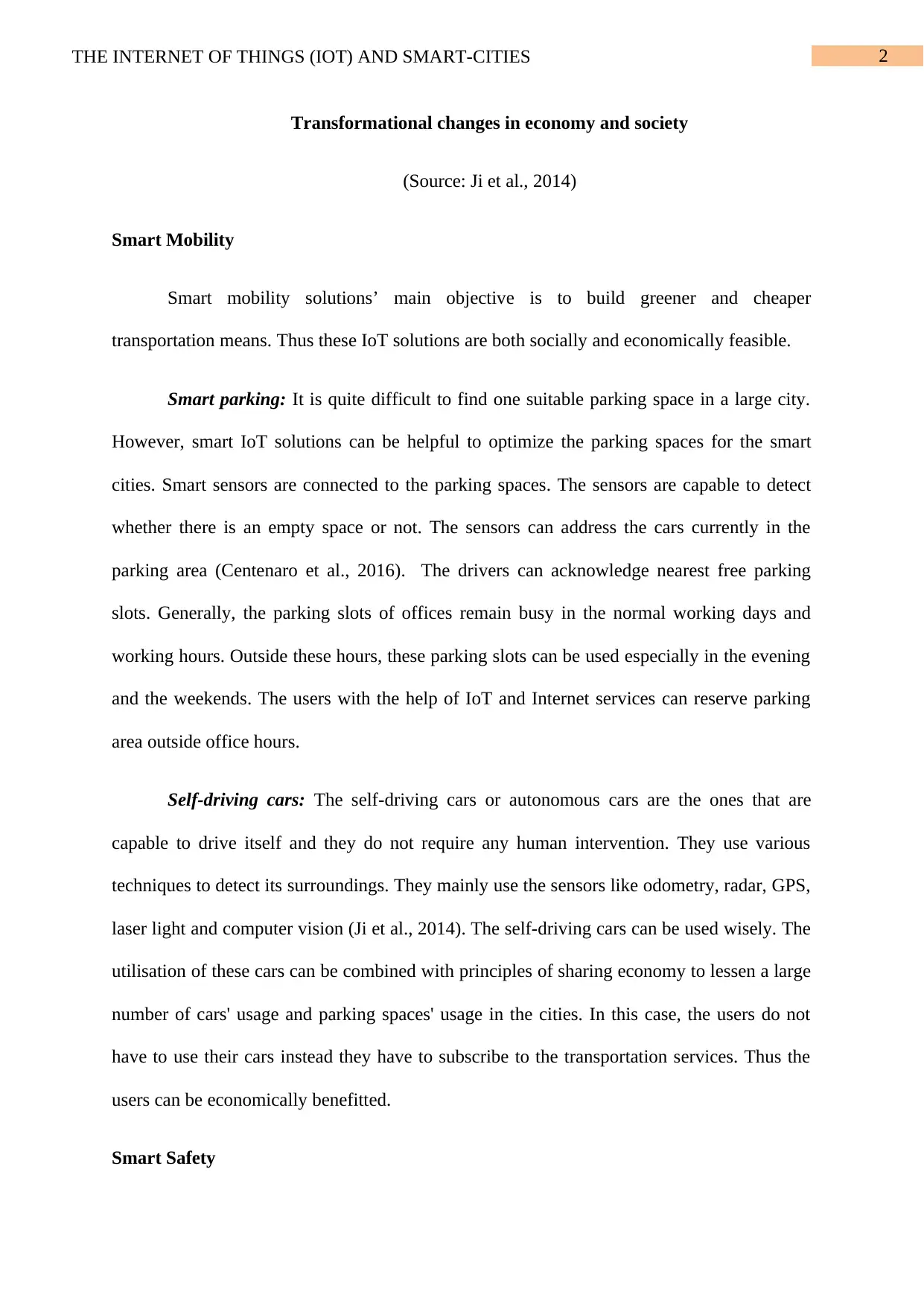
2THE INTERNET OF THINGS (IOT) AND SMART-CITIES
Transformational changes in economy and society
(Source: Ji et al., 2014)
Smart Mobility
Smart mobility solutions’ main objective is to build greener and cheaper
transportation means. Thus these IoT solutions are both socially and economically feasible.
Smart parking: It is quite difficult to find one suitable parking space in a large city.
However, smart IoT solutions can be helpful to optimize the parking spaces for the smart
cities. Smart sensors are connected to the parking spaces. The sensors are capable to detect
whether there is an empty space or not. The sensors can address the cars currently in the
parking area (Centenaro et al., 2016). The drivers can acknowledge nearest free parking
slots. Generally, the parking slots of offices remain busy in the normal working days and
working hours. Outside these hours, these parking slots can be used especially in the evening
and the weekends. The users with the help of IoT and Internet services can reserve parking
area outside office hours.
Self-driving cars: The self-driving cars or autonomous cars are the ones that are
capable to drive itself and they do not require any human intervention. They use various
techniques to detect its surroundings. They mainly use the sensors like odometry, radar, GPS,
laser light and computer vision (Ji et al., 2014). The self-driving cars can be used wisely. The
utilisation of these cars can be combined with principles of sharing economy to lessen a large
number of cars' usage and parking spaces' usage in the cities. In this case, the users do not
have to use their cars instead they have to subscribe to the transportation services. Thus the
users can be economically benefitted.
Smart Safety
Transformational changes in economy and society
(Source: Ji et al., 2014)
Smart Mobility
Smart mobility solutions’ main objective is to build greener and cheaper
transportation means. Thus these IoT solutions are both socially and economically feasible.
Smart parking: It is quite difficult to find one suitable parking space in a large city.
However, smart IoT solutions can be helpful to optimize the parking spaces for the smart
cities. Smart sensors are connected to the parking spaces. The sensors are capable to detect
whether there is an empty space or not. The sensors can address the cars currently in the
parking area (Centenaro et al., 2016). The drivers can acknowledge nearest free parking
slots. Generally, the parking slots of offices remain busy in the normal working days and
working hours. Outside these hours, these parking slots can be used especially in the evening
and the weekends. The users with the help of IoT and Internet services can reserve parking
area outside office hours.
Self-driving cars: The self-driving cars or autonomous cars are the ones that are
capable to drive itself and they do not require any human intervention. They use various
techniques to detect its surroundings. They mainly use the sensors like odometry, radar, GPS,
laser light and computer vision (Ji et al., 2014). The self-driving cars can be used wisely. The
utilisation of these cars can be combined with principles of sharing economy to lessen a large
number of cars' usage and parking spaces' usage in the cities. In this case, the users do not
have to use their cars instead they have to subscribe to the transportation services. Thus the
users can be economically benefitted.
Smart Safety
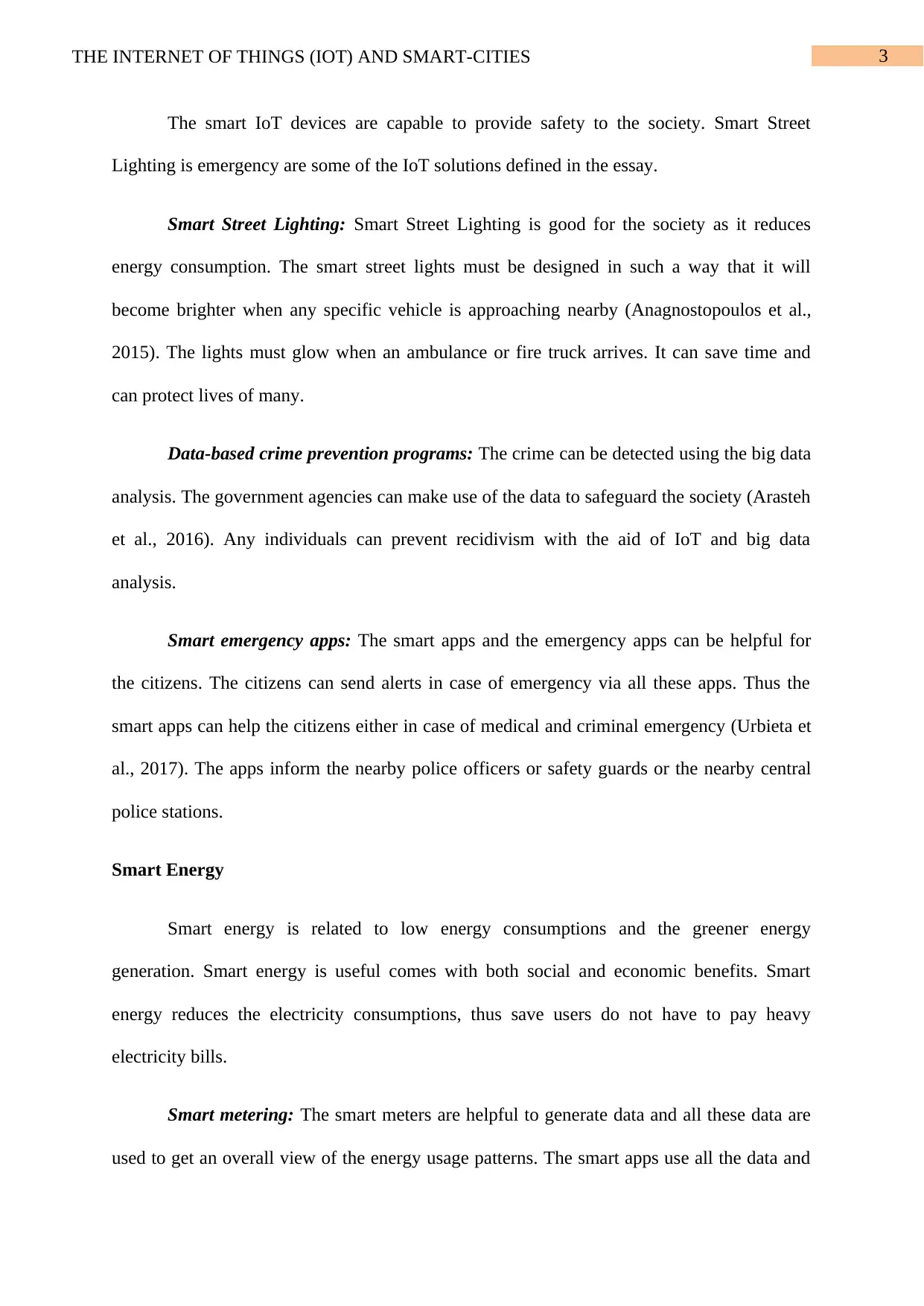
3THE INTERNET OF THINGS (IOT) AND SMART-CITIES
The smart IoT devices are capable to provide safety to the society. Smart Street
Lighting is emergency are some of the IoT solutions defined in the essay.
Smart Street Lighting: Smart Street Lighting is good for the society as it reduces
energy consumption. The smart street lights must be designed in such a way that it will
become brighter when any specific vehicle is approaching nearby (Anagnostopoulos et al.,
2015). The lights must glow when an ambulance or fire truck arrives. It can save time and
can protect lives of many.
Data-based crime prevention programs: The crime can be detected using the big data
analysis. The government agencies can make use of the data to safeguard the society (Arasteh
et al., 2016). Any individuals can prevent recidivism with the aid of IoT and big data
analysis.
Smart emergency apps: The smart apps and the emergency apps can be helpful for
the citizens. The citizens can send alerts in case of emergency via all these apps. Thus the
smart apps can help the citizens either in case of medical and criminal emergency (Urbieta et
al., 2017). The apps inform the nearby police officers or safety guards or the nearby central
police stations.
Smart Energy
Smart energy is related to low energy consumptions and the greener energy
generation. Smart energy is useful comes with both social and economic benefits. Smart
energy reduces the electricity consumptions, thus save users do not have to pay heavy
electricity bills.
Smart metering: The smart meters are helpful to generate data and all these data are
used to get an overall view of the energy usage patterns. The smart apps use all the data and
The smart IoT devices are capable to provide safety to the society. Smart Street
Lighting is emergency are some of the IoT solutions defined in the essay.
Smart Street Lighting: Smart Street Lighting is good for the society as it reduces
energy consumption. The smart street lights must be designed in such a way that it will
become brighter when any specific vehicle is approaching nearby (Anagnostopoulos et al.,
2015). The lights must glow when an ambulance or fire truck arrives. It can save time and
can protect lives of many.
Data-based crime prevention programs: The crime can be detected using the big data
analysis. The government agencies can make use of the data to safeguard the society (Arasteh
et al., 2016). Any individuals can prevent recidivism with the aid of IoT and big data
analysis.
Smart emergency apps: The smart apps and the emergency apps can be helpful for
the citizens. The citizens can send alerts in case of emergency via all these apps. Thus the
smart apps can help the citizens either in case of medical and criminal emergency (Urbieta et
al., 2017). The apps inform the nearby police officers or safety guards or the nearby central
police stations.
Smart Energy
Smart energy is related to low energy consumptions and the greener energy
generation. Smart energy is useful comes with both social and economic benefits. Smart
energy reduces the electricity consumptions, thus save users do not have to pay heavy
electricity bills.
Smart metering: The smart meters are helpful to generate data and all these data are
used to get an overall view of the energy usage patterns. The smart apps use all the data and
Secure Best Marks with AI Grader
Need help grading? Try our AI Grader for instant feedback on your assignments.

4THE INTERNET OF THINGS (IOT) AND SMART-CITIES
use concepts like the gamification (Khanna & Anand, 2016). The gamification can make the
consumers aware of the energy usage. The IoT thus can assist to decrease the energy
consumption.
Household devices: The IoT can be useful to manufacture household products or
household appliances like kitchen appliances.
Electric Vehicle charging: The vehicles which run on electric contain the battery.
The battery has high energy storage capacity. This gives scope to store energy at the time of
production peaks (Rathore et al., 2016). This also gives surplus energy at the time of the
consumption peaks. The storage capacity thus allows smart cities to utilise energy effectively.
Smart Water
Smart Water solutions help in the minimizing the waste. The cities can get smart due
to the smart water solutions. Smart IoT solution is useful for the society. Smart water solution
comes with several economic benefits, water wastage can be minimized, and water can be
reused.
Leakage detection: The water scarcity and population growth have become important
due to water loss management. The water providers equip the distribution network with the
sensors in such a way such that they can provide real-time insight into quality, pressure and
flows (Perera et al., 2014). The sensors can give the real-time data and it gives detail insight
about the leakages. Thus all the leakages can be assessed and minimized. This approach is
good for the society and smart cities. Water loss can be minimized.
Pollution detection: The IoT and smart sensors are capable to detect water quality and
thus the sensors are capable to detect the emergence of pollution. It provides solutions by
which the sustainability of the city resources can be detected.
use concepts like the gamification (Khanna & Anand, 2016). The gamification can make the
consumers aware of the energy usage. The IoT thus can assist to decrease the energy
consumption.
Household devices: The IoT can be useful to manufacture household products or
household appliances like kitchen appliances.
Electric Vehicle charging: The vehicles which run on electric contain the battery.
The battery has high energy storage capacity. This gives scope to store energy at the time of
production peaks (Rathore et al., 2016). This also gives surplus energy at the time of the
consumption peaks. The storage capacity thus allows smart cities to utilise energy effectively.
Smart Water
Smart Water solutions help in the minimizing the waste. The cities can get smart due
to the smart water solutions. Smart IoT solution is useful for the society. Smart water solution
comes with several economic benefits, water wastage can be minimized, and water can be
reused.
Leakage detection: The water scarcity and population growth have become important
due to water loss management. The water providers equip the distribution network with the
sensors in such a way such that they can provide real-time insight into quality, pressure and
flows (Perera et al., 2014). The sensors can give the real-time data and it gives detail insight
about the leakages. Thus all the leakages can be assessed and minimized. This approach is
good for the society and smart cities. Water loss can be minimized.
Pollution detection: The IoT and smart sensors are capable to detect water quality and
thus the sensors are capable to detect the emergence of pollution. It provides solutions by
which the sustainability of the city resources can be detected.

5THE INTERNET OF THINGS (IOT) AND SMART-CITIES
Warning for flooding: Smart cities can suffer due to the excessive storm and rain.
The smart sensors use the predictive analysis and by combing the geographical data along
with weather forecast data detect the flood-prone zones and the times (Anagnostopoulos et
al., 2017). Thus IoT and smart sensors can make the citizens of the smart cities aware of
floods and the disaster.
Smart Buildings
Smart IoT sensors have the capabilities to simplify the lifestyle of the users residing in
smart buildings. The sensors are capable to enhance one’s social lifestyle and safety.
Power consumption: The smart buildings have the capability to adjust the power
consumption at the time of electricity scarcity (Toenjes, Kuemper & Fischer, 2015). If the
loads are high or the voltage is high, the smart IoT energy grid can send a message to the
smart building to lower the power consumption.
Smart refilling: Coffee machine and towel dispensaries require smart refilling.
Refilling must be done in proper time. If the refilling is done too early then the owner of the
buildings will have to bear heavy costs. If the refilling is done too late, then the users will get
unsatisfactory results.
Renewable energy: Smart buildings use the renewable energy like the thermal energy
storage and the IoT solar panel to minimize the energy usage.
Usage-based cleaning: IoT sensors can be used for the cleaning purpose. The robots
work on commands and clean rooms and buildings.
Smart Homes
Warning for flooding: Smart cities can suffer due to the excessive storm and rain.
The smart sensors use the predictive analysis and by combing the geographical data along
with weather forecast data detect the flood-prone zones and the times (Anagnostopoulos et
al., 2017). Thus IoT and smart sensors can make the citizens of the smart cities aware of
floods and the disaster.
Smart Buildings
Smart IoT sensors have the capabilities to simplify the lifestyle of the users residing in
smart buildings. The sensors are capable to enhance one’s social lifestyle and safety.
Power consumption: The smart buildings have the capability to adjust the power
consumption at the time of electricity scarcity (Toenjes, Kuemper & Fischer, 2015). If the
loads are high or the voltage is high, the smart IoT energy grid can send a message to the
smart building to lower the power consumption.
Smart refilling: Coffee machine and towel dispensaries require smart refilling.
Refilling must be done in proper time. If the refilling is done too early then the owner of the
buildings will have to bear heavy costs. If the refilling is done too late, then the users will get
unsatisfactory results.
Renewable energy: Smart buildings use the renewable energy like the thermal energy
storage and the IoT solar panel to minimize the energy usage.
Usage-based cleaning: IoT sensors can be used for the cleaning purpose. The robots
work on commands and clean rooms and buildings.
Smart Homes
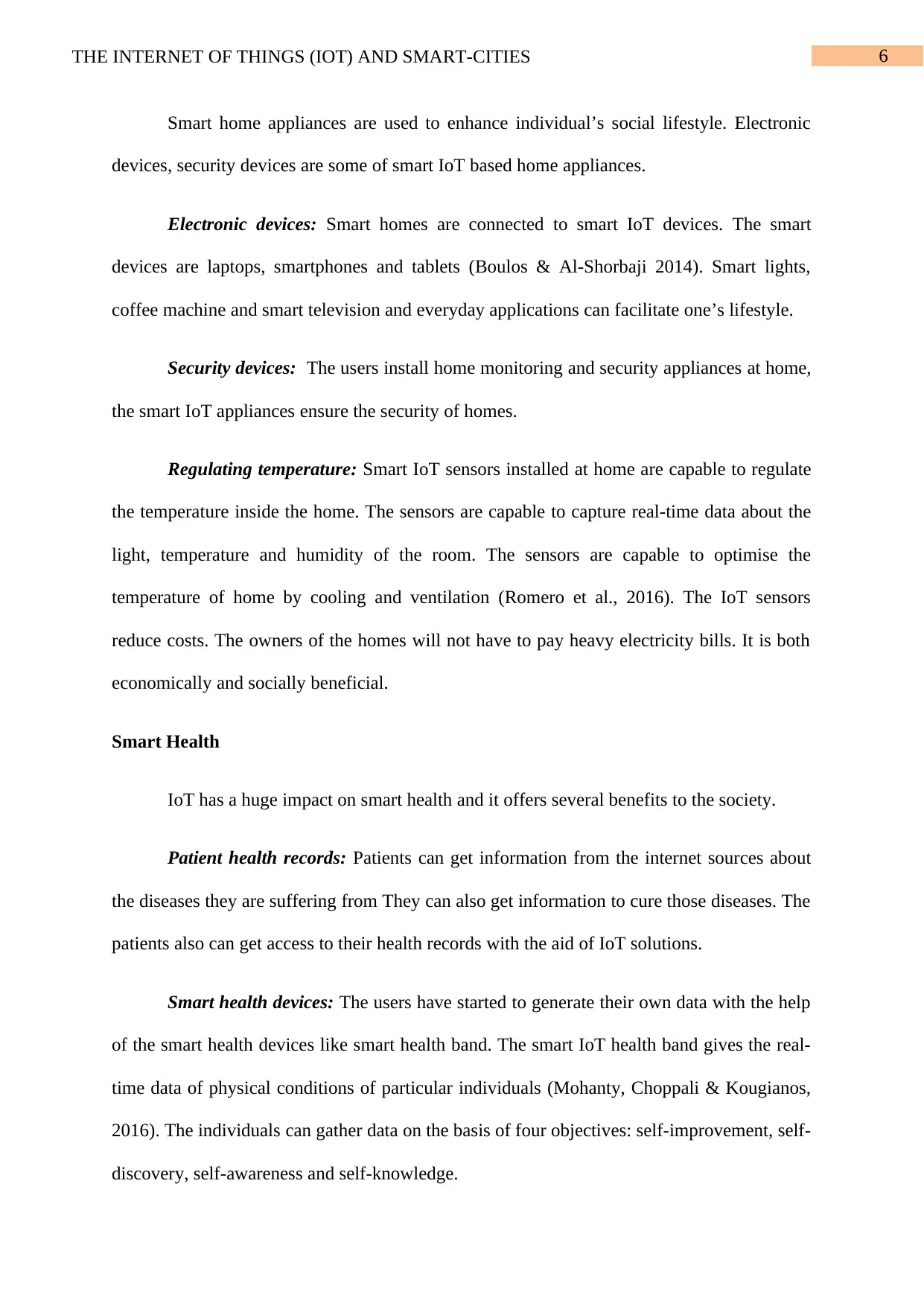
6THE INTERNET OF THINGS (IOT) AND SMART-CITIES
Smart home appliances are used to enhance individual’s social lifestyle. Electronic
devices, security devices are some of smart IoT based home appliances.
Electronic devices: Smart homes are connected to smart IoT devices. The smart
devices are laptops, smartphones and tablets (Boulos & Al-Shorbaji 2014). Smart lights,
coffee machine and smart television and everyday applications can facilitate one’s lifestyle.
Security devices: The users install home monitoring and security appliances at home,
the smart IoT appliances ensure the security of homes.
Regulating temperature: Smart IoT sensors installed at home are capable to regulate
the temperature inside the home. The sensors are capable to capture real-time data about the
light, temperature and humidity of the room. The sensors are capable to optimise the
temperature of home by cooling and ventilation (Romero et al., 2016). The IoT sensors
reduce costs. The owners of the homes will not have to pay heavy electricity bills. It is both
economically and socially beneficial.
Smart Health
IoT has a huge impact on smart health and it offers several benefits to the society.
Patient health records: Patients can get information from the internet sources about
the diseases they are suffering from They can also get information to cure those diseases. The
patients also can get access to their health records with the aid of IoT solutions.
Smart health devices: The users have started to generate their own data with the help
of the smart health devices like smart health band. The smart IoT health band gives the real-
time data of physical conditions of particular individuals (Mohanty, Choppali & Kougianos,
2016). The individuals can gather data on the basis of four objectives: self-improvement, self-
discovery, self-awareness and self-knowledge.
Smart home appliances are used to enhance individual’s social lifestyle. Electronic
devices, security devices are some of smart IoT based home appliances.
Electronic devices: Smart homes are connected to smart IoT devices. The smart
devices are laptops, smartphones and tablets (Boulos & Al-Shorbaji 2014). Smart lights,
coffee machine and smart television and everyday applications can facilitate one’s lifestyle.
Security devices: The users install home monitoring and security appliances at home,
the smart IoT appliances ensure the security of homes.
Regulating temperature: Smart IoT sensors installed at home are capable to regulate
the temperature inside the home. The sensors are capable to capture real-time data about the
light, temperature and humidity of the room. The sensors are capable to optimise the
temperature of home by cooling and ventilation (Romero et al., 2016). The IoT sensors
reduce costs. The owners of the homes will not have to pay heavy electricity bills. It is both
economically and socially beneficial.
Smart Health
IoT has a huge impact on smart health and it offers several benefits to the society.
Patient health records: Patients can get information from the internet sources about
the diseases they are suffering from They can also get information to cure those diseases. The
patients also can get access to their health records with the aid of IoT solutions.
Smart health devices: The users have started to generate their own data with the help
of the smart health devices like smart health band. The smart IoT health band gives the real-
time data of physical conditions of particular individuals (Mohanty, Choppali & Kougianos,
2016). The individuals can gather data on the basis of four objectives: self-improvement, self-
discovery, self-awareness and self-knowledge.
Paraphrase This Document
Need a fresh take? Get an instant paraphrase of this document with our AI Paraphraser
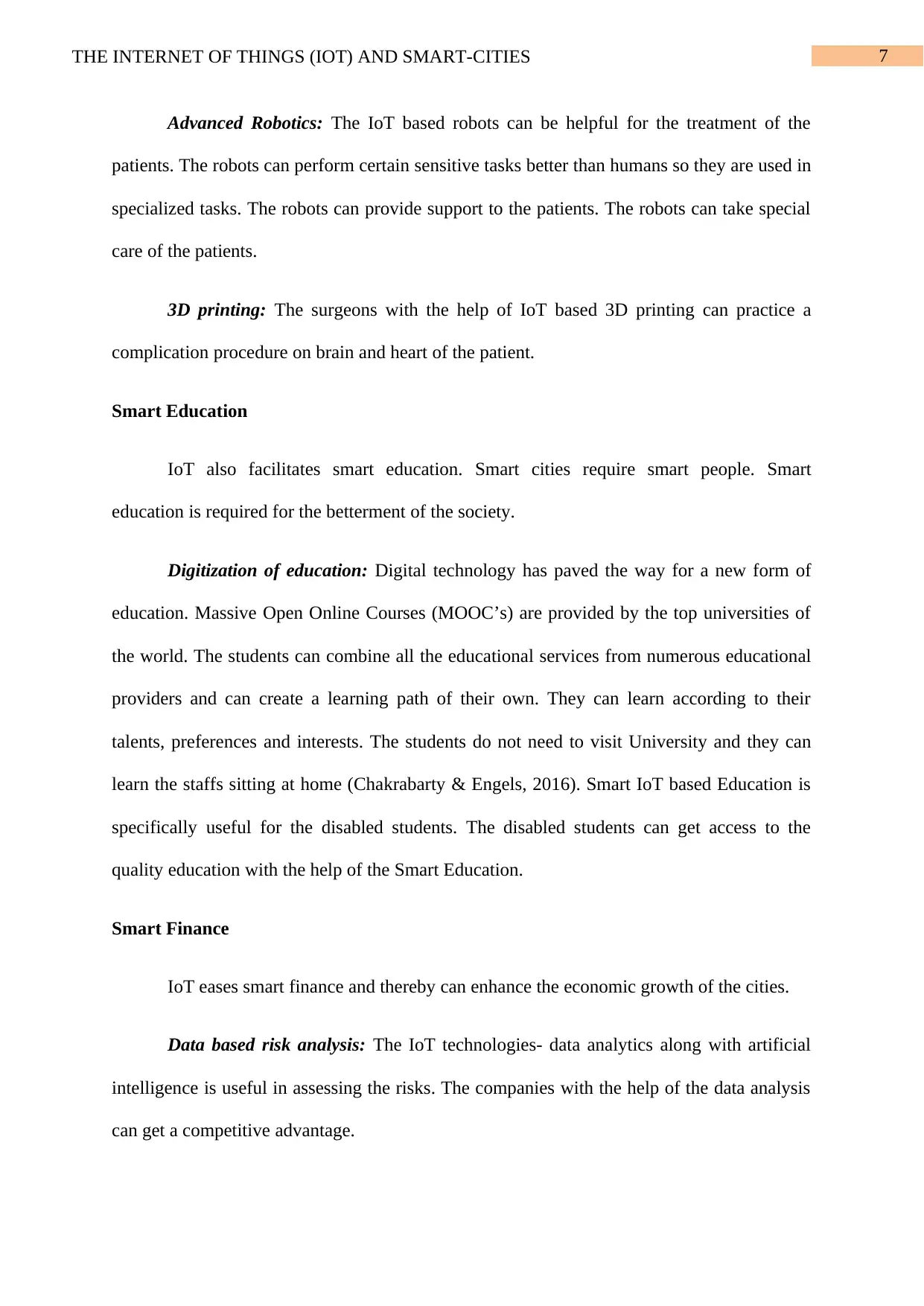
7THE INTERNET OF THINGS (IOT) AND SMART-CITIES
Advanced Robotics: The IoT based robots can be helpful for the treatment of the
patients. The robots can perform certain sensitive tasks better than humans so they are used in
specialized tasks. The robots can provide support to the patients. The robots can take special
care of the patients.
3D printing: The surgeons with the help of IoT based 3D printing can practice a
complication procedure on brain and heart of the patient.
Smart Education
IoT also facilitates smart education. Smart cities require smart people. Smart
education is required for the betterment of the society.
Digitization of education: Digital technology has paved the way for a new form of
education. Massive Open Online Courses (MOOC’s) are provided by the top universities of
the world. The students can combine all the educational services from numerous educational
providers and can create a learning path of their own. They can learn according to their
talents, preferences and interests. The students do not need to visit University and they can
learn the staffs sitting at home (Chakrabarty & Engels, 2016). Smart IoT based Education is
specifically useful for the disabled students. The disabled students can get access to the
quality education with the help of the Smart Education.
Smart Finance
IoT eases smart finance and thereby can enhance the economic growth of the cities.
Data based risk analysis: The IoT technologies- data analytics along with artificial
intelligence is useful in assessing the risks. The companies with the help of the data analysis
can get a competitive advantage.
Advanced Robotics: The IoT based robots can be helpful for the treatment of the
patients. The robots can perform certain sensitive tasks better than humans so they are used in
specialized tasks. The robots can provide support to the patients. The robots can take special
care of the patients.
3D printing: The surgeons with the help of IoT based 3D printing can practice a
complication procedure on brain and heart of the patient.
Smart Education
IoT also facilitates smart education. Smart cities require smart people. Smart
education is required for the betterment of the society.
Digitization of education: Digital technology has paved the way for a new form of
education. Massive Open Online Courses (MOOC’s) are provided by the top universities of
the world. The students can combine all the educational services from numerous educational
providers and can create a learning path of their own. They can learn according to their
talents, preferences and interests. The students do not need to visit University and they can
learn the staffs sitting at home (Chakrabarty & Engels, 2016). Smart IoT based Education is
specifically useful for the disabled students. The disabled students can get access to the
quality education with the help of the Smart Education.
Smart Finance
IoT eases smart finance and thereby can enhance the economic growth of the cities.
Data based risk analysis: The IoT technologies- data analytics along with artificial
intelligence is useful in assessing the risks. The companies with the help of the data analysis
can get a competitive advantage.
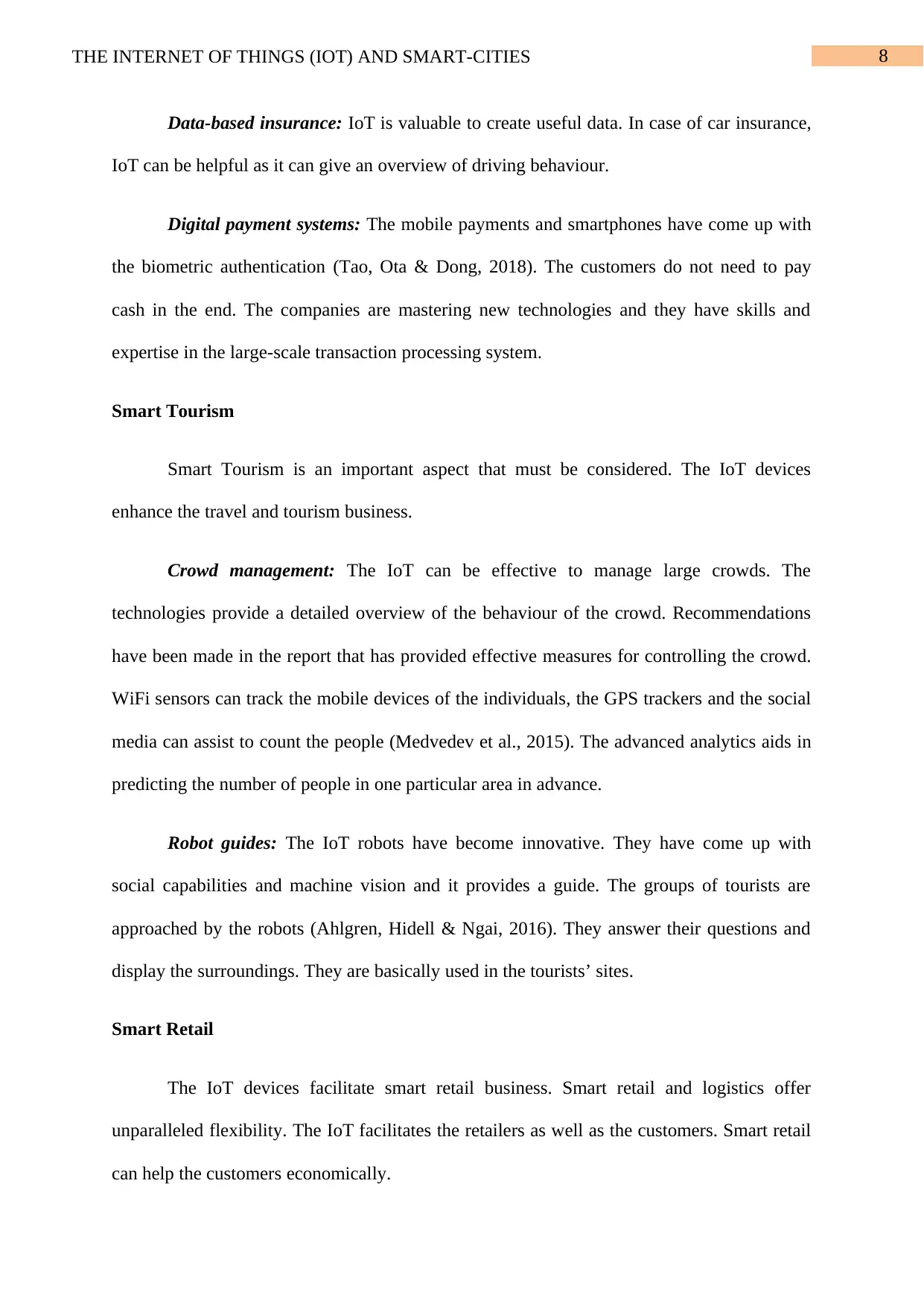
8THE INTERNET OF THINGS (IOT) AND SMART-CITIES
Data-based insurance: IoT is valuable to create useful data. In case of car insurance,
IoT can be helpful as it can give an overview of driving behaviour.
Digital payment systems: The mobile payments and smartphones have come up with
the biometric authentication (Tao, Ota & Dong, 2018). The customers do not need to pay
cash in the end. The companies are mastering new technologies and they have skills and
expertise in the large-scale transaction processing system.
Smart Tourism
Smart Tourism is an important aspect that must be considered. The IoT devices
enhance the travel and tourism business.
Crowd management: The IoT can be effective to manage large crowds. The
technologies provide a detailed overview of the behaviour of the crowd. Recommendations
have been made in the report that has provided effective measures for controlling the crowd.
WiFi sensors can track the mobile devices of the individuals, the GPS trackers and the social
media can assist to count the people (Medvedev et al., 2015). The advanced analytics aids in
predicting the number of people in one particular area in advance.
Robot guides: The IoT robots have become innovative. They have come up with
social capabilities and machine vision and it provides a guide. The groups of tourists are
approached by the robots (Ahlgren, Hidell & Ngai, 2016). They answer their questions and
display the surroundings. They are basically used in the tourists’ sites.
Smart Retail
The IoT devices facilitate smart retail business. Smart retail and logistics offer
unparalleled flexibility. The IoT facilitates the retailers as well as the customers. Smart retail
can help the customers economically.
Data-based insurance: IoT is valuable to create useful data. In case of car insurance,
IoT can be helpful as it can give an overview of driving behaviour.
Digital payment systems: The mobile payments and smartphones have come up with
the biometric authentication (Tao, Ota & Dong, 2018). The customers do not need to pay
cash in the end. The companies are mastering new technologies and they have skills and
expertise in the large-scale transaction processing system.
Smart Tourism
Smart Tourism is an important aspect that must be considered. The IoT devices
enhance the travel and tourism business.
Crowd management: The IoT can be effective to manage large crowds. The
technologies provide a detailed overview of the behaviour of the crowd. Recommendations
have been made in the report that has provided effective measures for controlling the crowd.
WiFi sensors can track the mobile devices of the individuals, the GPS trackers and the social
media can assist to count the people (Medvedev et al., 2015). The advanced analytics aids in
predicting the number of people in one particular area in advance.
Robot guides: The IoT robots have become innovative. They have come up with
social capabilities and machine vision and it provides a guide. The groups of tourists are
approached by the robots (Ahlgren, Hidell & Ngai, 2016). They answer their questions and
display the surroundings. They are basically used in the tourists’ sites.
Smart Retail
The IoT devices facilitate smart retail business. Smart retail and logistics offer
unparalleled flexibility. The IoT facilitates the retailers as well as the customers. Smart retail
can help the customers economically.
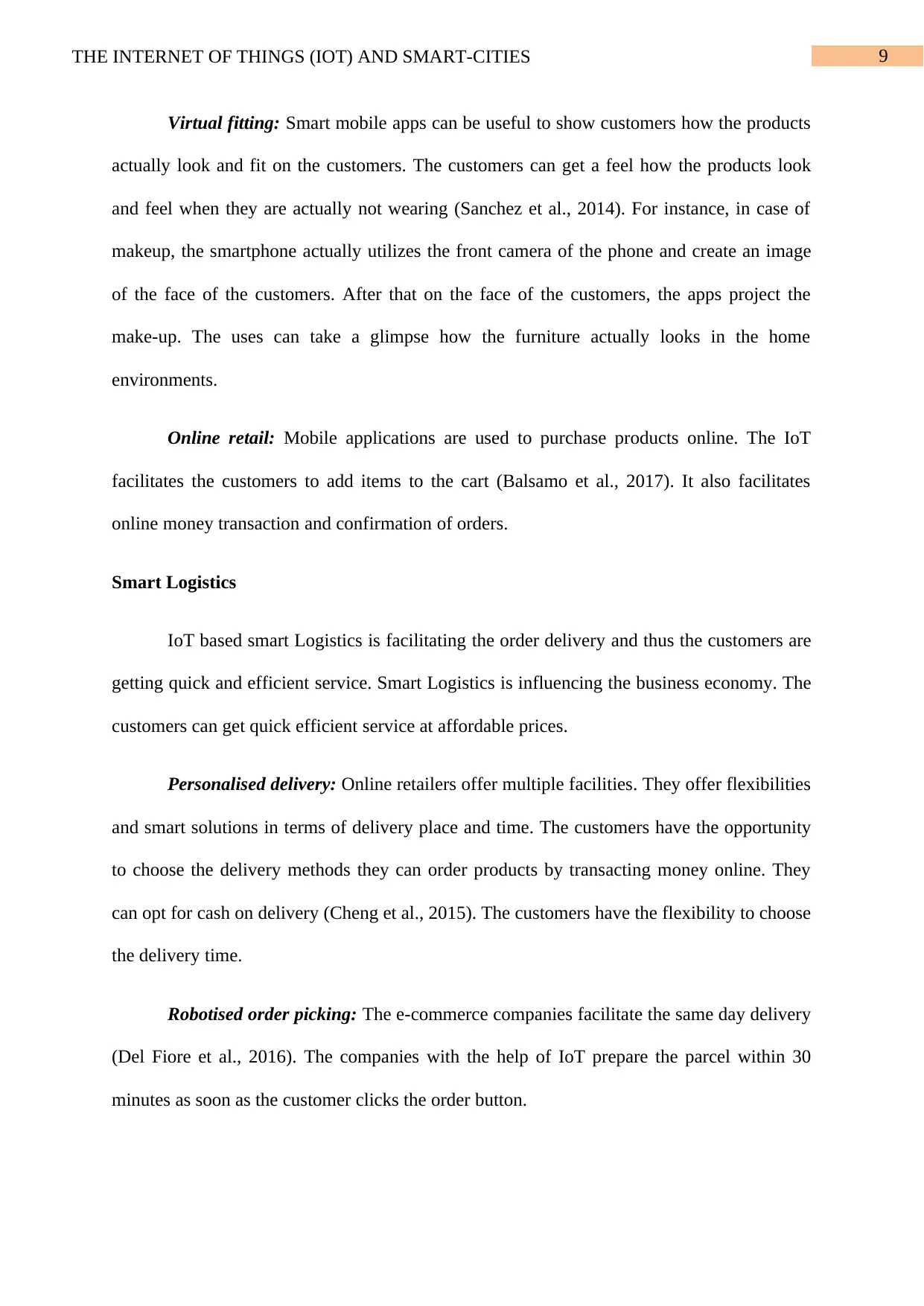
9THE INTERNET OF THINGS (IOT) AND SMART-CITIES
Virtual fitting: Smart mobile apps can be useful to show customers how the products
actually look and fit on the customers. The customers can get a feel how the products look
and feel when they are actually not wearing (Sanchez et al., 2014). For instance, in case of
makeup, the smartphone actually utilizes the front camera of the phone and create an image
of the face of the customers. After that on the face of the customers, the apps project the
make-up. The uses can take a glimpse how the furniture actually looks in the home
environments.
Online retail: Mobile applications are used to purchase products online. The IoT
facilitates the customers to add items to the cart (Balsamo et al., 2017). It also facilitates
online money transaction and confirmation of orders.
Smart Logistics
IoT based smart Logistics is facilitating the order delivery and thus the customers are
getting quick and efficient service. Smart Logistics is influencing the business economy. The
customers can get quick efficient service at affordable prices.
Personalised delivery: Online retailers offer multiple facilities. They offer flexibilities
and smart solutions in terms of delivery place and time. The customers have the opportunity
to choose the delivery methods they can order products by transacting money online. They
can opt for cash on delivery (Cheng et al., 2015). The customers have the flexibility to choose
the delivery time.
Robotised order picking: The e-commerce companies facilitate the same day delivery
(Del Fiore et al., 2016). The companies with the help of IoT prepare the parcel within 30
minutes as soon as the customer clicks the order button.
Virtual fitting: Smart mobile apps can be useful to show customers how the products
actually look and fit on the customers. The customers can get a feel how the products look
and feel when they are actually not wearing (Sanchez et al., 2014). For instance, in case of
makeup, the smartphone actually utilizes the front camera of the phone and create an image
of the face of the customers. After that on the face of the customers, the apps project the
make-up. The uses can take a glimpse how the furniture actually looks in the home
environments.
Online retail: Mobile applications are used to purchase products online. The IoT
facilitates the customers to add items to the cart (Balsamo et al., 2017). It also facilitates
online money transaction and confirmation of orders.
Smart Logistics
IoT based smart Logistics is facilitating the order delivery and thus the customers are
getting quick and efficient service. Smart Logistics is influencing the business economy. The
customers can get quick efficient service at affordable prices.
Personalised delivery: Online retailers offer multiple facilities. They offer flexibilities
and smart solutions in terms of delivery place and time. The customers have the opportunity
to choose the delivery methods they can order products by transacting money online. They
can opt for cash on delivery (Cheng et al., 2015). The customers have the flexibility to choose
the delivery time.
Robotised order picking: The e-commerce companies facilitate the same day delivery
(Del Fiore et al., 2016). The companies with the help of IoT prepare the parcel within 30
minutes as soon as the customer clicks the order button.
Secure Best Marks with AI Grader
Need help grading? Try our AI Grader for instant feedback on your assignments.
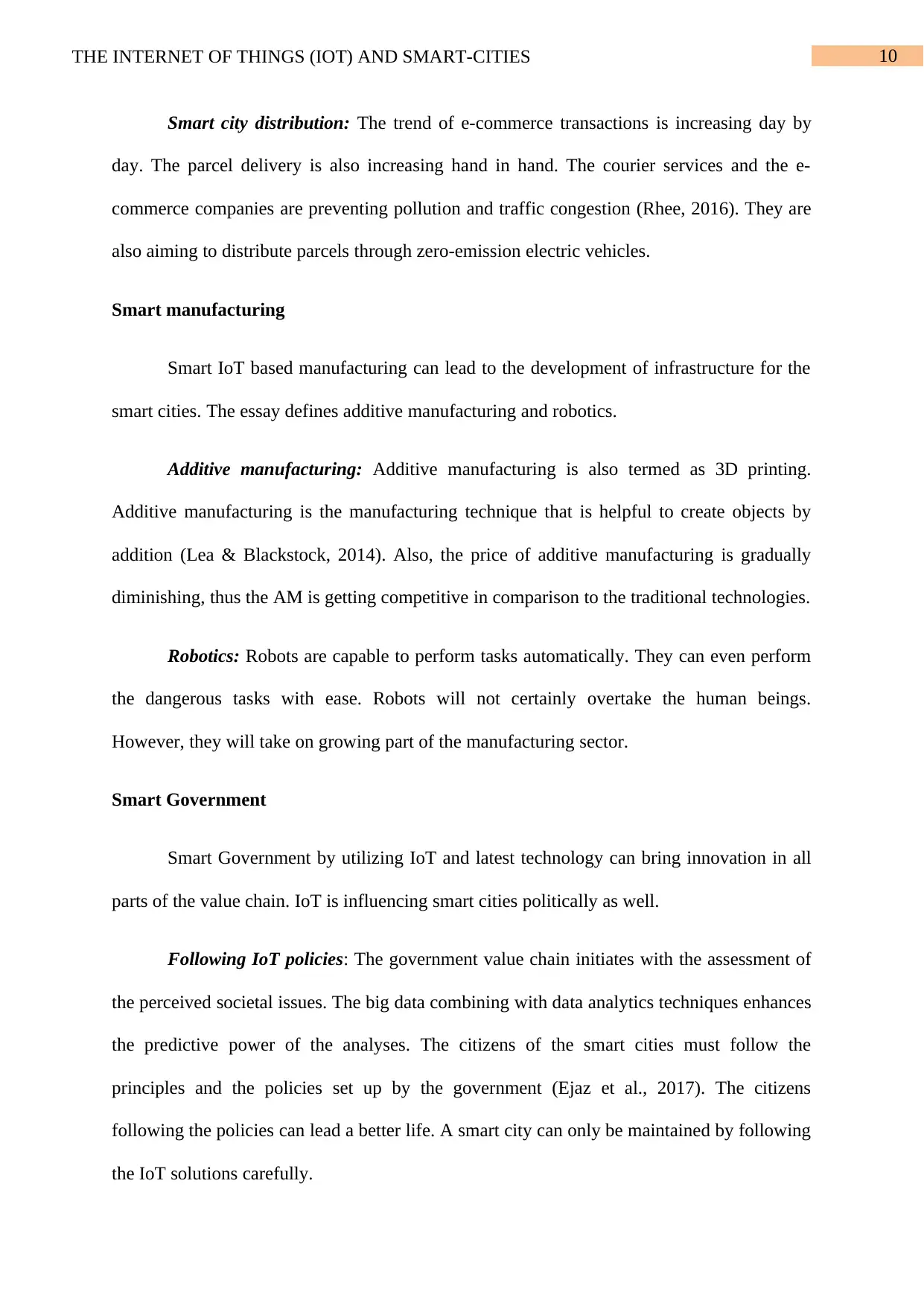
10THE INTERNET OF THINGS (IOT) AND SMART-CITIES
Smart city distribution: The trend of e-commerce transactions is increasing day by
day. The parcel delivery is also increasing hand in hand. The courier services and the e-
commerce companies are preventing pollution and traffic congestion (Rhee, 2016). They are
also aiming to distribute parcels through zero-emission electric vehicles.
Smart manufacturing
Smart IoT based manufacturing can lead to the development of infrastructure for the
smart cities. The essay defines additive manufacturing and robotics.
Additive manufacturing: Additive manufacturing is also termed as 3D printing.
Additive manufacturing is the manufacturing technique that is helpful to create objects by
addition (Lea & Blackstock, 2014). Also, the price of additive manufacturing is gradually
diminishing, thus the AM is getting competitive in comparison to the traditional technologies.
Robotics: Robots are capable to perform tasks automatically. They can even perform
the dangerous tasks with ease. Robots will not certainly overtake the human beings.
However, they will take on growing part of the manufacturing sector.
Smart Government
Smart Government by utilizing IoT and latest technology can bring innovation in all
parts of the value chain. IoT is influencing smart cities politically as well.
Following IoT policies: The government value chain initiates with the assessment of
the perceived societal issues. The big data combining with data analytics techniques enhances
the predictive power of the analyses. The citizens of the smart cities must follow the
principles and the policies set up by the government (Ejaz et al., 2017). The citizens
following the policies can lead a better life. A smart city can only be maintained by following
the IoT solutions carefully.
Smart city distribution: The trend of e-commerce transactions is increasing day by
day. The parcel delivery is also increasing hand in hand. The courier services and the e-
commerce companies are preventing pollution and traffic congestion (Rhee, 2016). They are
also aiming to distribute parcels through zero-emission electric vehicles.
Smart manufacturing
Smart IoT based manufacturing can lead to the development of infrastructure for the
smart cities. The essay defines additive manufacturing and robotics.
Additive manufacturing: Additive manufacturing is also termed as 3D printing.
Additive manufacturing is the manufacturing technique that is helpful to create objects by
addition (Lea & Blackstock, 2014). Also, the price of additive manufacturing is gradually
diminishing, thus the AM is getting competitive in comparison to the traditional technologies.
Robotics: Robots are capable to perform tasks automatically. They can even perform
the dangerous tasks with ease. Robots will not certainly overtake the human beings.
However, they will take on growing part of the manufacturing sector.
Smart Government
Smart Government by utilizing IoT and latest technology can bring innovation in all
parts of the value chain. IoT is influencing smart cities politically as well.
Following IoT policies: The government value chain initiates with the assessment of
the perceived societal issues. The big data combining with data analytics techniques enhances
the predictive power of the analyses. The citizens of the smart cities must follow the
principles and the policies set up by the government (Ejaz et al., 2017). The citizens
following the policies can lead a better life. A smart city can only be maintained by following
the IoT solutions carefully.

11THE INTERNET OF THINGS (IOT) AND SMART-CITIES
It can be concluded from the above discourse that IoT devices like self-driving cars,
drones, robots, 3D printing and big data can enhance the growth of smart cities. IoT is
basically a system of connected physical objects like digital machines, mechanical devices
and computing devices. The objects can be accessed through the Internet. The IoT solutions
can create a great impact on smart cities economically, socially and politically and the essay
has elaborated all those impacts in details. The IoT devices generally influence the areas-
water, health, education, finance, buildings and livings, retails and logistics and government
and essay have discussed all these aspects in details.
It can be concluded from the above discourse that IoT devices like self-driving cars,
drones, robots, 3D printing and big data can enhance the growth of smart cities. IoT is
basically a system of connected physical objects like digital machines, mechanical devices
and computing devices. The objects can be accessed through the Internet. The IoT solutions
can create a great impact on smart cities economically, socially and politically and the essay
has elaborated all those impacts in details. The IoT devices generally influence the areas-
water, health, education, finance, buildings and livings, retails and logistics and government
and essay have discussed all these aspects in details.
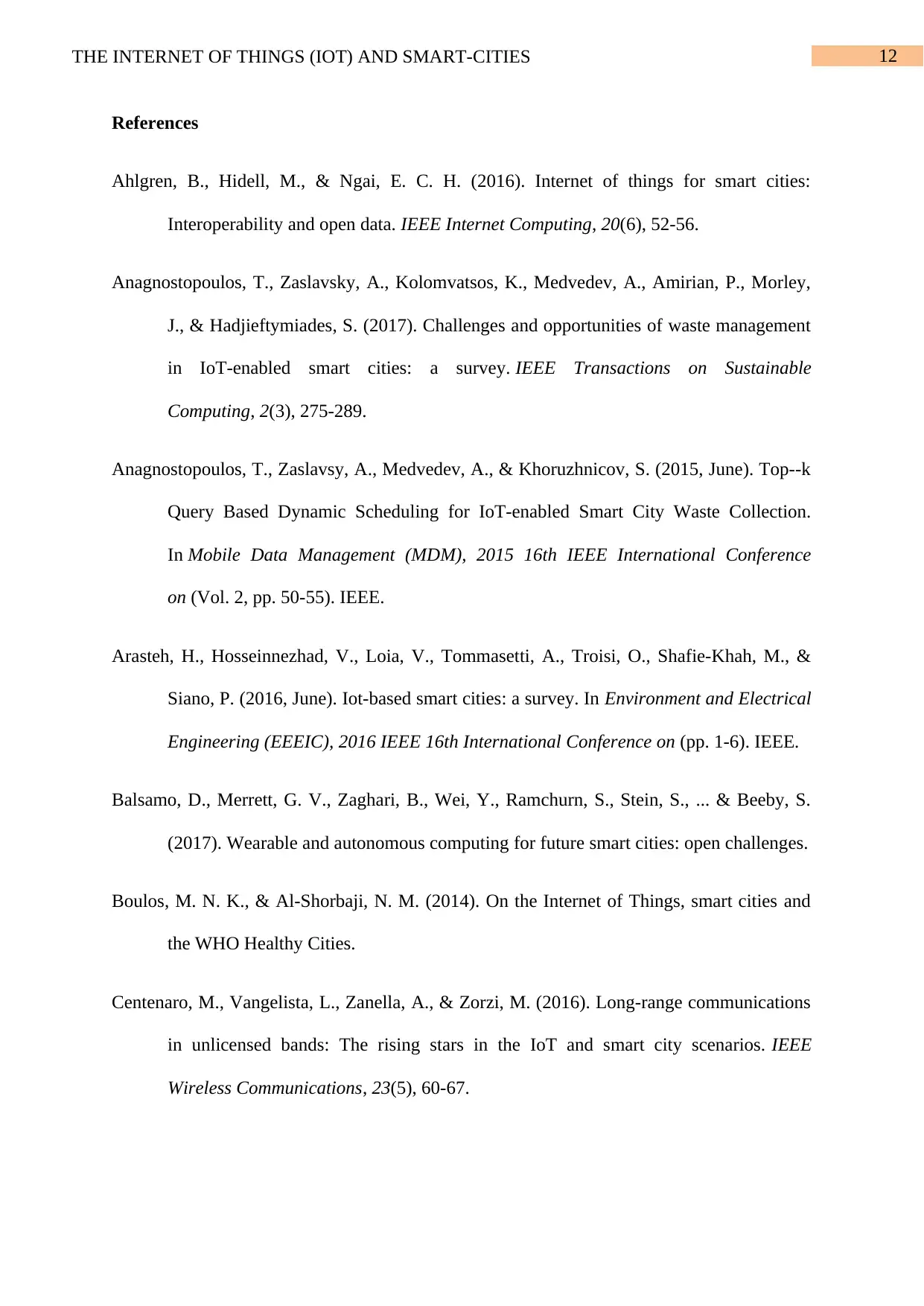
12THE INTERNET OF THINGS (IOT) AND SMART-CITIES
References
Ahlgren, B., Hidell, M., & Ngai, E. C. H. (2016). Internet of things for smart cities:
Interoperability and open data. IEEE Internet Computing, 20(6), 52-56.
Anagnostopoulos, T., Zaslavsky, A., Kolomvatsos, K., Medvedev, A., Amirian, P., Morley,
J., & Hadjieftymiades, S. (2017). Challenges and opportunities of waste management
in IoT-enabled smart cities: a survey. IEEE Transactions on Sustainable
Computing, 2(3), 275-289.
Anagnostopoulos, T., Zaslavsy, A., Medvedev, A., & Khoruzhnicov, S. (2015, June). Top--k
Query Based Dynamic Scheduling for IoT-enabled Smart City Waste Collection.
In Mobile Data Management (MDM), 2015 16th IEEE International Conference
on (Vol. 2, pp. 50-55). IEEE.
Arasteh, H., Hosseinnezhad, V., Loia, V., Tommasetti, A., Troisi, O., Shafie-Khah, M., &
Siano, P. (2016, June). Iot-based smart cities: a survey. In Environment and Electrical
Engineering (EEEIC), 2016 IEEE 16th International Conference on (pp. 1-6). IEEE.
Balsamo, D., Merrett, G. V., Zaghari, B., Wei, Y., Ramchurn, S., Stein, S., ... & Beeby, S.
(2017). Wearable and autonomous computing for future smart cities: open challenges.
Boulos, M. N. K., & Al-Shorbaji, N. M. (2014). On the Internet of Things, smart cities and
the WHO Healthy Cities.
Centenaro, M., Vangelista, L., Zanella, A., & Zorzi, M. (2016). Long-range communications
in unlicensed bands: The rising stars in the IoT and smart city scenarios. IEEE
Wireless Communications, 23(5), 60-67.
References
Ahlgren, B., Hidell, M., & Ngai, E. C. H. (2016). Internet of things for smart cities:
Interoperability and open data. IEEE Internet Computing, 20(6), 52-56.
Anagnostopoulos, T., Zaslavsky, A., Kolomvatsos, K., Medvedev, A., Amirian, P., Morley,
J., & Hadjieftymiades, S. (2017). Challenges and opportunities of waste management
in IoT-enabled smart cities: a survey. IEEE Transactions on Sustainable
Computing, 2(3), 275-289.
Anagnostopoulos, T., Zaslavsy, A., Medvedev, A., & Khoruzhnicov, S. (2015, June). Top--k
Query Based Dynamic Scheduling for IoT-enabled Smart City Waste Collection.
In Mobile Data Management (MDM), 2015 16th IEEE International Conference
on (Vol. 2, pp. 50-55). IEEE.
Arasteh, H., Hosseinnezhad, V., Loia, V., Tommasetti, A., Troisi, O., Shafie-Khah, M., &
Siano, P. (2016, June). Iot-based smart cities: a survey. In Environment and Electrical
Engineering (EEEIC), 2016 IEEE 16th International Conference on (pp. 1-6). IEEE.
Balsamo, D., Merrett, G. V., Zaghari, B., Wei, Y., Ramchurn, S., Stein, S., ... & Beeby, S.
(2017). Wearable and autonomous computing for future smart cities: open challenges.
Boulos, M. N. K., & Al-Shorbaji, N. M. (2014). On the Internet of Things, smart cities and
the WHO Healthy Cities.
Centenaro, M., Vangelista, L., Zanella, A., & Zorzi, M. (2016). Long-range communications
in unlicensed bands: The rising stars in the IoT and smart city scenarios. IEEE
Wireless Communications, 23(5), 60-67.
Paraphrase This Document
Need a fresh take? Get an instant paraphrase of this document with our AI Paraphraser
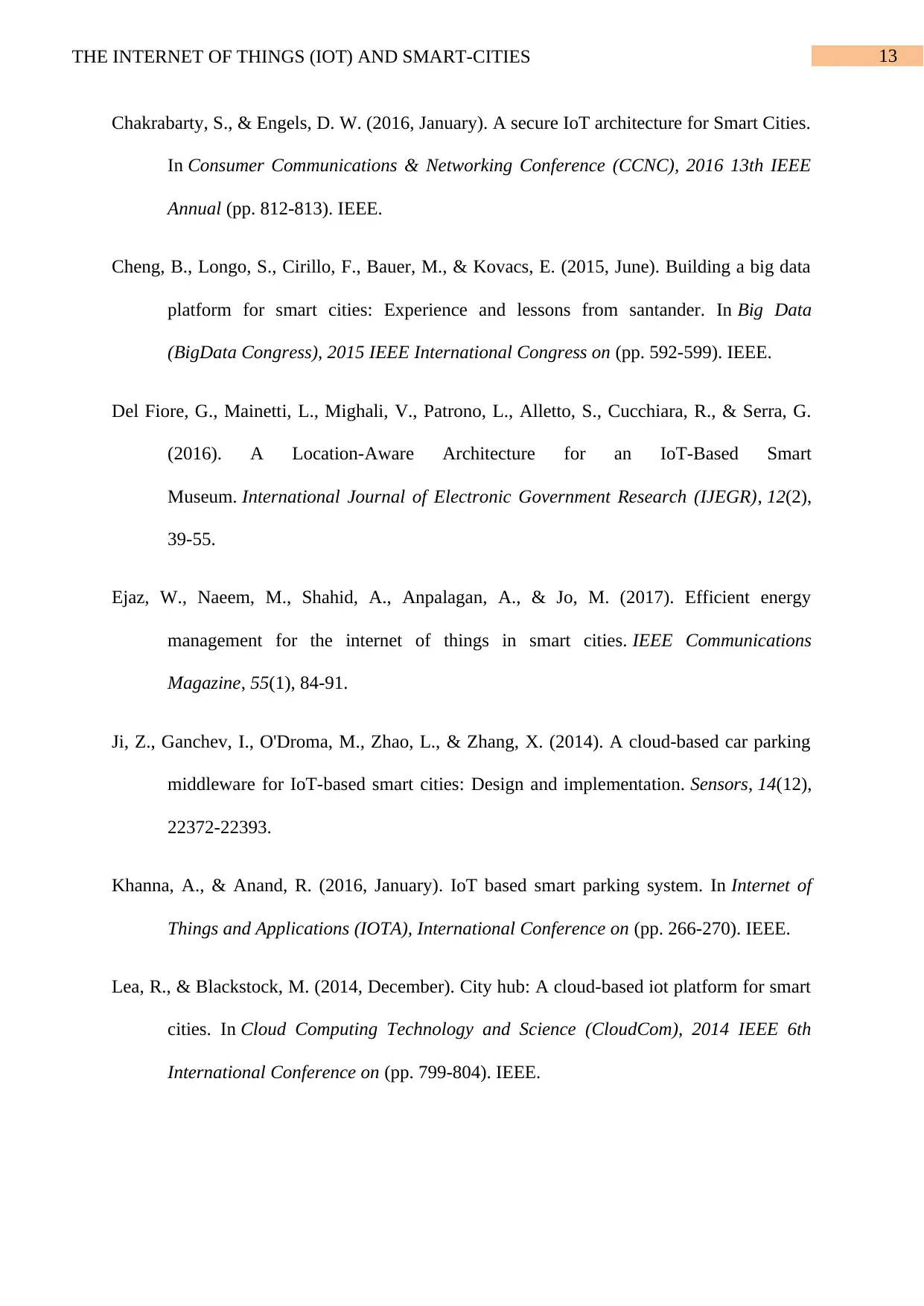
13THE INTERNET OF THINGS (IOT) AND SMART-CITIES
Chakrabarty, S., & Engels, D. W. (2016, January). A secure IoT architecture for Smart Cities.
In Consumer Communications & Networking Conference (CCNC), 2016 13th IEEE
Annual (pp. 812-813). IEEE.
Cheng, B., Longo, S., Cirillo, F., Bauer, M., & Kovacs, E. (2015, June). Building a big data
platform for smart cities: Experience and lessons from santander. In Big Data
(BigData Congress), 2015 IEEE International Congress on (pp. 592-599). IEEE.
Del Fiore, G., Mainetti, L., Mighali, V., Patrono, L., Alletto, S., Cucchiara, R., & Serra, G.
(2016). A Location-Aware Architecture for an IoT-Based Smart
Museum. International Journal of Electronic Government Research (IJEGR), 12(2),
39-55.
Ejaz, W., Naeem, M., Shahid, A., Anpalagan, A., & Jo, M. (2017). Efficient energy
management for the internet of things in smart cities. IEEE Communications
Magazine, 55(1), 84-91.
Ji, Z., Ganchev, I., O'Droma, M., Zhao, L., & Zhang, X. (2014). A cloud-based car parking
middleware for IoT-based smart cities: Design and implementation. Sensors, 14(12),
22372-22393.
Khanna, A., & Anand, R. (2016, January). IoT based smart parking system. In Internet of
Things and Applications (IOTA), International Conference on (pp. 266-270). IEEE.
Lea, R., & Blackstock, M. (2014, December). City hub: A cloud-based iot platform for smart
cities. In Cloud Computing Technology and Science (CloudCom), 2014 IEEE 6th
International Conference on (pp. 799-804). IEEE.
Chakrabarty, S., & Engels, D. W. (2016, January). A secure IoT architecture for Smart Cities.
In Consumer Communications & Networking Conference (CCNC), 2016 13th IEEE
Annual (pp. 812-813). IEEE.
Cheng, B., Longo, S., Cirillo, F., Bauer, M., & Kovacs, E. (2015, June). Building a big data
platform for smart cities: Experience and lessons from santander. In Big Data
(BigData Congress), 2015 IEEE International Congress on (pp. 592-599). IEEE.
Del Fiore, G., Mainetti, L., Mighali, V., Patrono, L., Alletto, S., Cucchiara, R., & Serra, G.
(2016). A Location-Aware Architecture for an IoT-Based Smart
Museum. International Journal of Electronic Government Research (IJEGR), 12(2),
39-55.
Ejaz, W., Naeem, M., Shahid, A., Anpalagan, A., & Jo, M. (2017). Efficient energy
management for the internet of things in smart cities. IEEE Communications
Magazine, 55(1), 84-91.
Ji, Z., Ganchev, I., O'Droma, M., Zhao, L., & Zhang, X. (2014). A cloud-based car parking
middleware for IoT-based smart cities: Design and implementation. Sensors, 14(12),
22372-22393.
Khanna, A., & Anand, R. (2016, January). IoT based smart parking system. In Internet of
Things and Applications (IOTA), International Conference on (pp. 266-270). IEEE.
Lea, R., & Blackstock, M. (2014, December). City hub: A cloud-based iot platform for smart
cities. In Cloud Computing Technology and Science (CloudCom), 2014 IEEE 6th
International Conference on (pp. 799-804). IEEE.
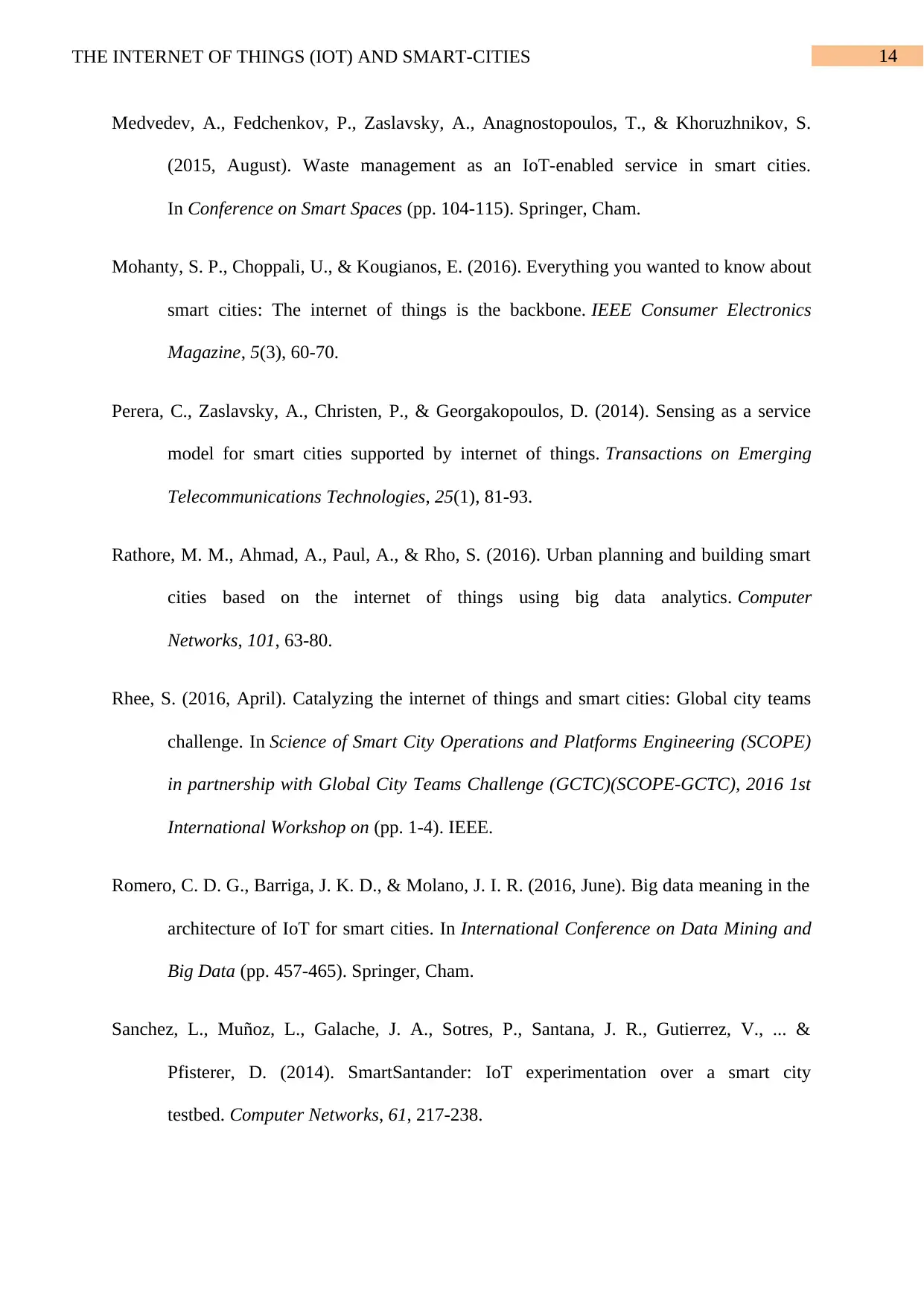
14THE INTERNET OF THINGS (IOT) AND SMART-CITIES
Medvedev, A., Fedchenkov, P., Zaslavsky, A., Anagnostopoulos, T., & Khoruzhnikov, S.
(2015, August). Waste management as an IoT-enabled service in smart cities.
In Conference on Smart Spaces (pp. 104-115). Springer, Cham.
Mohanty, S. P., Choppali, U., & Kougianos, E. (2016). Everything you wanted to know about
smart cities: The internet of things is the backbone. IEEE Consumer Electronics
Magazine, 5(3), 60-70.
Perera, C., Zaslavsky, A., Christen, P., & Georgakopoulos, D. (2014). Sensing as a service
model for smart cities supported by internet of things. Transactions on Emerging
Telecommunications Technologies, 25(1), 81-93.
Rathore, M. M., Ahmad, A., Paul, A., & Rho, S. (2016). Urban planning and building smart
cities based on the internet of things using big data analytics. Computer
Networks, 101, 63-80.
Rhee, S. (2016, April). Catalyzing the internet of things and smart cities: Global city teams
challenge. In Science of Smart City Operations and Platforms Engineering (SCOPE)
in partnership with Global City Teams Challenge (GCTC)(SCOPE-GCTC), 2016 1st
International Workshop on (pp. 1-4). IEEE.
Romero, C. D. G., Barriga, J. K. D., & Molano, J. I. R. (2016, June). Big data meaning in the
architecture of IoT for smart cities. In International Conference on Data Mining and
Big Data (pp. 457-465). Springer, Cham.
Sanchez, L., Muñoz, L., Galache, J. A., Sotres, P., Santana, J. R., Gutierrez, V., ... &
Pfisterer, D. (2014). SmartSantander: IoT experimentation over a smart city
testbed. Computer Networks, 61, 217-238.
Medvedev, A., Fedchenkov, P., Zaslavsky, A., Anagnostopoulos, T., & Khoruzhnikov, S.
(2015, August). Waste management as an IoT-enabled service in smart cities.
In Conference on Smart Spaces (pp. 104-115). Springer, Cham.
Mohanty, S. P., Choppali, U., & Kougianos, E. (2016). Everything you wanted to know about
smart cities: The internet of things is the backbone. IEEE Consumer Electronics
Magazine, 5(3), 60-70.
Perera, C., Zaslavsky, A., Christen, P., & Georgakopoulos, D. (2014). Sensing as a service
model for smart cities supported by internet of things. Transactions on Emerging
Telecommunications Technologies, 25(1), 81-93.
Rathore, M. M., Ahmad, A., Paul, A., & Rho, S. (2016). Urban planning and building smart
cities based on the internet of things using big data analytics. Computer
Networks, 101, 63-80.
Rhee, S. (2016, April). Catalyzing the internet of things and smart cities: Global city teams
challenge. In Science of Smart City Operations and Platforms Engineering (SCOPE)
in partnership with Global City Teams Challenge (GCTC)(SCOPE-GCTC), 2016 1st
International Workshop on (pp. 1-4). IEEE.
Romero, C. D. G., Barriga, J. K. D., & Molano, J. I. R. (2016, June). Big data meaning in the
architecture of IoT for smart cities. In International Conference on Data Mining and
Big Data (pp. 457-465). Springer, Cham.
Sanchez, L., Muñoz, L., Galache, J. A., Sotres, P., Santana, J. R., Gutierrez, V., ... &
Pfisterer, D. (2014). SmartSantander: IoT experimentation over a smart city
testbed. Computer Networks, 61, 217-238.
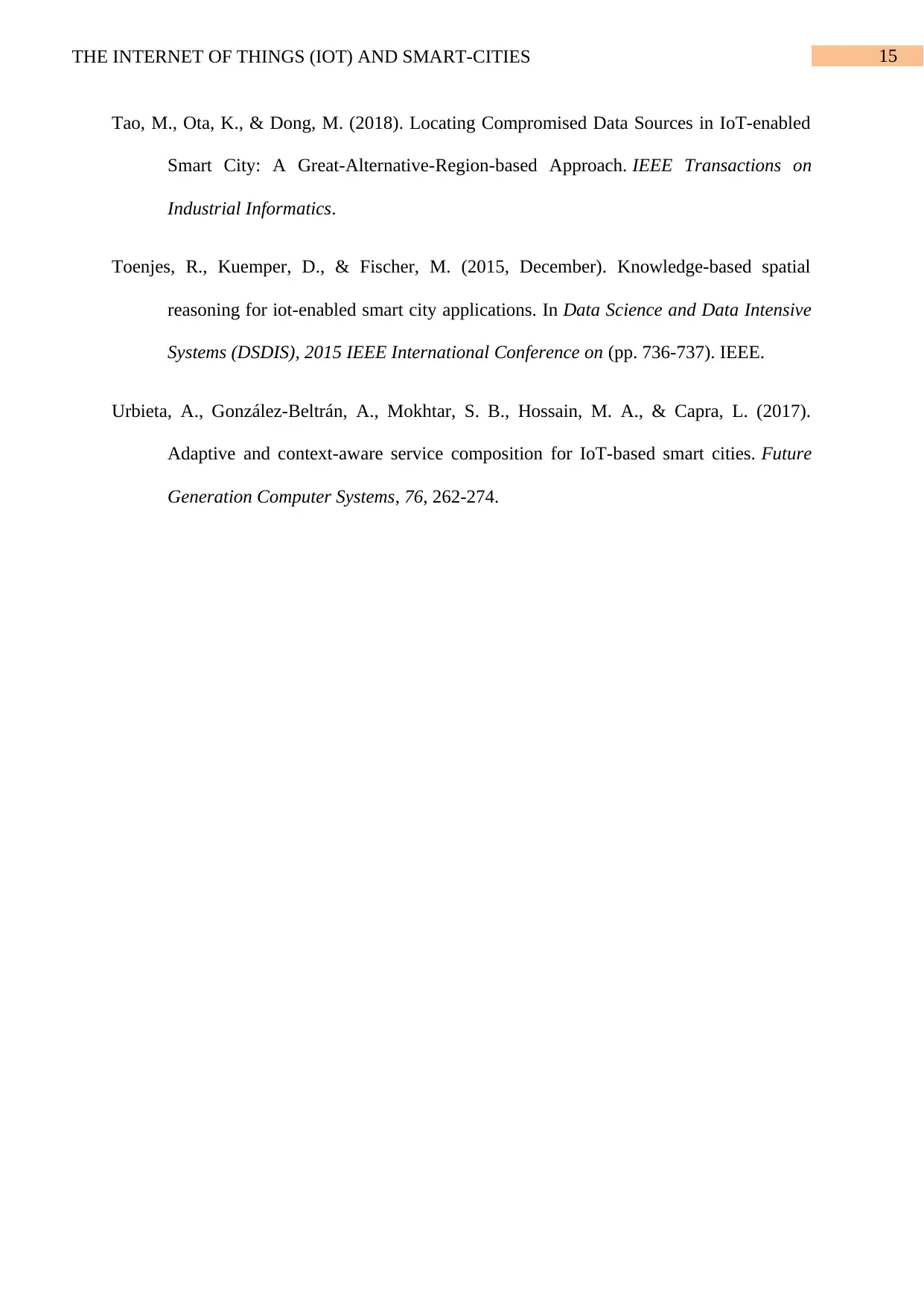
15THE INTERNET OF THINGS (IOT) AND SMART-CITIES
Tao, M., Ota, K., & Dong, M. (2018). Locating Compromised Data Sources in IoT-enabled
Smart City: A Great-Alternative-Region-based Approach. IEEE Transactions on
Industrial Informatics.
Toenjes, R., Kuemper, D., & Fischer, M. (2015, December). Knowledge-based spatial
reasoning for iot-enabled smart city applications. In Data Science and Data Intensive
Systems (DSDIS), 2015 IEEE International Conference on (pp. 736-737). IEEE.
Urbieta, A., González-Beltrán, A., Mokhtar, S. B., Hossain, M. A., & Capra, L. (2017).
Adaptive and context-aware service composition for IoT-based smart cities. Future
Generation Computer Systems, 76, 262-274.
Tao, M., Ota, K., & Dong, M. (2018). Locating Compromised Data Sources in IoT-enabled
Smart City: A Great-Alternative-Region-based Approach. IEEE Transactions on
Industrial Informatics.
Toenjes, R., Kuemper, D., & Fischer, M. (2015, December). Knowledge-based spatial
reasoning for iot-enabled smart city applications. In Data Science and Data Intensive
Systems (DSDIS), 2015 IEEE International Conference on (pp. 736-737). IEEE.
Urbieta, A., González-Beltrán, A., Mokhtar, S. B., Hossain, M. A., & Capra, L. (2017).
Adaptive and context-aware service composition for IoT-based smart cities. Future
Generation Computer Systems, 76, 262-274.
1 out of 16
Related Documents
Your All-in-One AI-Powered Toolkit for Academic Success.
+13062052269
info@desklib.com
Available 24*7 on WhatsApp / Email
![[object Object]](/_next/static/media/star-bottom.7253800d.svg)
Unlock your academic potential
© 2024 | Zucol Services PVT LTD | All rights reserved.




